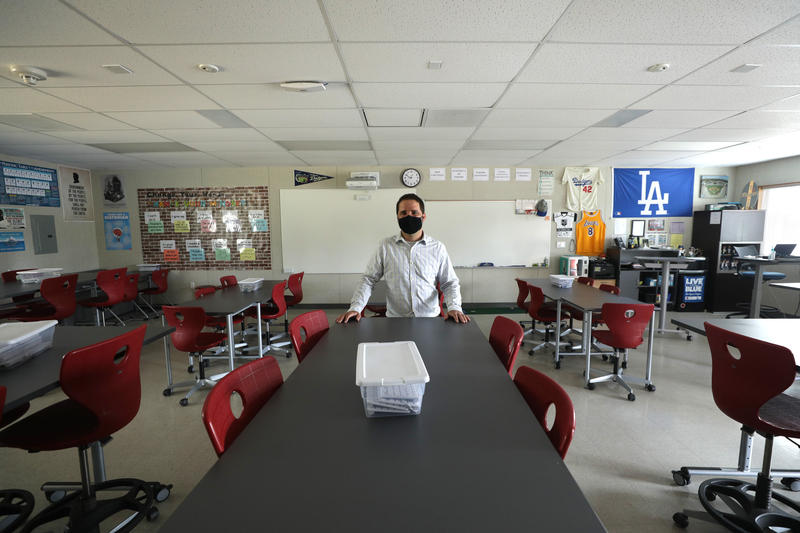The California Department of Public Health issued information Monday on what it would take for elementary schools to open for in-person instruction in counties where schools otherwise would be closed because of high rates of the coronavirus infection.
The new requirements are extensive, and the sample application form is lengthy. County public health directors will have latitude to phase in schools’ plans and limit the number of schools that can open in their counties.
The state document also recommends, with a passage in bold print, that county health departments prohibit any exceptions in counties where the numbers of coronavirus infections are more than 200 cases per 100,000 population. That’s twice the rate of the current threshold that puts counties on the school closure list and would rule out elementary school waivers for 14 of the 38 counties currently on the state’s monitoring list.
They include hot spots Kern (429 cases per 100,000) and Los Angeles (338 cases per 100,000) counties, along with Riverside, San Bernardino, San Joaquin and Santa Barbara counties. Fresno County is close to the threshold.
Also on Monday, state health officials published guidance that will permit some youth sports to resume. School-based and club sports will be permitted if 6 feet between individuals can be maintained with a stable cohort of participants, such as a class of students. Sports and other outdoor activities that require close contact are not allowed. Events that promote congregating — such as tournaments — are also not permitted. The guidance comes after the California Interscholastic Federation announced last month that fall high school sports would be postponed until 2021.
The possibility of obtaining an elementary school waiver from countywide school closures appeared as a one-paragraph footnote on the first page of a 5-page guidance that the state issued July 17. The document detailed the process for re-opening schools in counties that have been placed on a minimum 14-day monitoring list because of criteria measuring the spread of the coronavirus.
There was immediate interest from small private schools, dependent on tuition. Traditional school districts in rural counties and districts interested in sending to school small groups of children who have struggled with distance learning — foster children, English learners and students with disabilities — could be candidates as well.
“There is widespread interest; most private schools resume campus-based instruction at the earliest date conditions are deemed safe to do so,” said Ron Reynolds, executive director of the California Association of Private School Organizations.
Reynolds characterized the safety protocols for the waiver as “appropriate, rigorous, comprehensive and thoughtful — in line with what I had expected.”
“Airing on the side of caution is warranted, but with a path forward if conditions are met,” he said, adding, “Some schools will find (the conditions) hard to accept than others; private schools encompass a wide range of views.”
The guidance lists conditions that must be met in applying for a waiver. They include:
- A school or district must publish a school’s reopening plan online and, before applying, consult with parents, community organizations, and teachers or, in the case of school districts, employee unions. Teachers unions have indicated they’d oppose waivers from school closures, but the guidance doesn’t require their consent to apply. Schools must provide proof that they did seek their perspectives with the applications;
- Applications should be submitted at least 14 days before the planned date to reopen;
- The application will apply only to TK to 6th grade, even if the school includes 7th and 8th grades.
- “Based on the current best available scientific evidence, Covid-related risks in schools serving elementary-age students (grades TK-6) are lower than and different from the risks to staff and to students in schools serving older students,” the department said in an FAQ accompanying the guidance.
- The school must show evidence that it would comply with all of the safety and hygiene requirements for opening elementary schools, as listed in the CDPH/CalOSHA Guidance for Schools and School-Based Programs. These include a 6-foot social distancing requirement, face covering requirements, staff training and family education and student and staff testing.
In Santa Clara County, where the county superintendent of public schools and the director of public health sent out a letter inviting public and private school officials to apply for the waiver, the Diocese of San Jose plans to apply on behalf of all Catholic schools in the region, and the Khan Lab School, an in-person small private school, is pursuing a waiver to teach children outside in tents, founder Sal Khan told EdSource last week.
San Jose Unified, the county’s largest district, and Palo Alto Unified have no immediate plans to pursue a waiver, administrators said.
Napa County Superintendent of Schools Barbara Nemko, said Tuesday that 11 private schools that indicated they would apply for a waiver. However, the county public health department notified them that no waivers would be considered until later in August or September because of fast-increasing incidents of coronavirus, she said. No public schools have indicated an interest in a waiver, she said.
